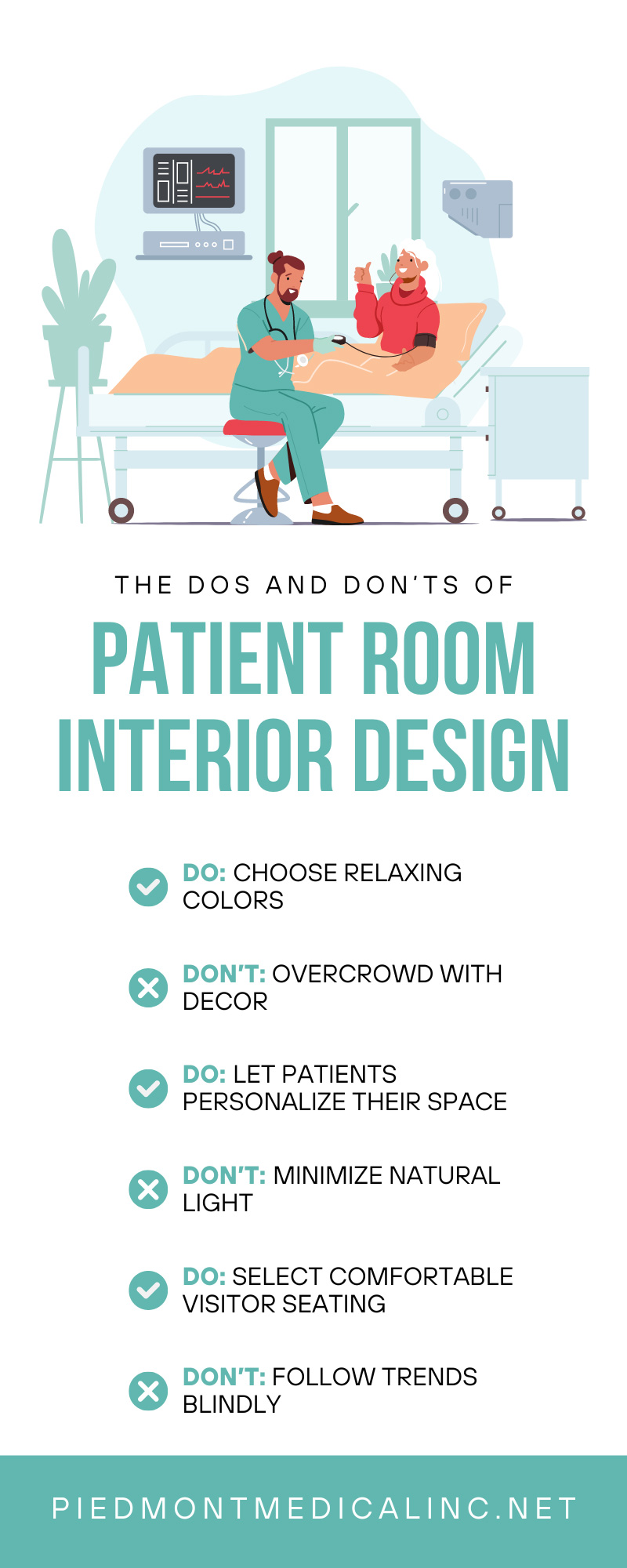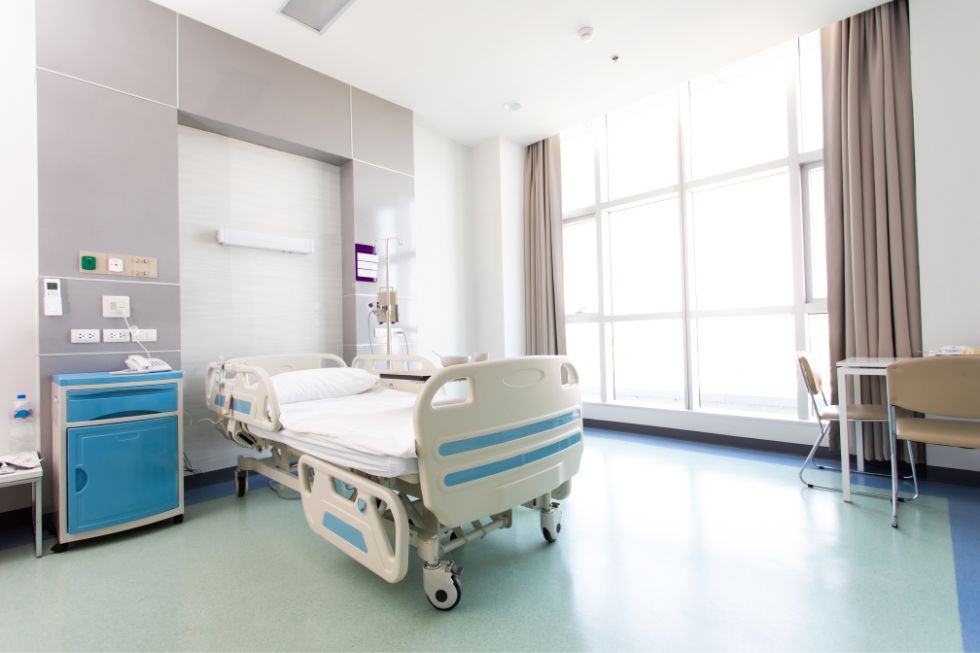Patient room design affects patient recovery and the ease and efficiency of providing healthcare. Optimal room design enhances patient comfort, promotes safety, and supports the medical staff’s ability to deliver care effectively. Balance aesthetic, functional, and psychological design factors by following the dos and don’ts of patient room interior design.
Do: Choose Relaxing Colors
Selecting the right color palette for patient rooms is vital for creating a calming and healing environment. Soft, soothing colors like blues, greens, and gentle lavender tones promote relaxation and have a positive impact on patients’ moods. These colors mimic the serenity of nature, creating a tranquil space that can significantly reduce stress and anxiety levels in patients.
Conversely, bright, overly saturated colors like neon shades or intense reds and oranges can make the rooms less welcoming. These colors can feel overwhelming for patients and cause agitation or anxiety. Instead, opting for warmer, muted tones like peach, soft yellow, or cream can evoke a sense of warmth and comfort without overwhelming the senses.
Don’t: Overcrowd With Decor
Overcrowding a patient room with decorations and furniture can significantly impede its functionality, making it difficult for healthcare professionals to maneuver and provide care. Clutter also creates a stressful environment for patients, potentially hampering the recovery process.
To avoid overcrowding, select practical and space-efficient furniture and focus on the essentials, such as a comfortable bed, a bedside table, and a chair for visitors. Incorporating built-in storage solutions can also help minimize clutter. Furthermore, opting for wall-mounted fixtures and decorations can enhance the room’s appearance without taking up valuable floor space, ensuring the area remains open and accessible.
Do: Let Patients Personalize Their Space
Making patient rooms feel more personal involves incorporating elements that suit each individual’s preferences and life outside the healthcare setting. You can achieve this by allowing patients to display personal items, such as family photos, artwork, or small personal mementos. These items can transform a sterile, impersonal space into one that feels more comforting and familiar.
Furthermore, incorporating adjustable lighting and window treatments enables patients to adjust their environments according to their comfort and mood. Natural light and the ability to modify the room can greatly contribute to making a space feel less clinical.
Don’t: Minimize Natural Light
Natural light can improve patients’ moods, enhance sleep quality, and give patients a stronger connection to the external environment. Exposure to sunlight has been shown to regulate sleep patterns by influencing the body’s melatonin production, which can especially benefit patients who spend extended periods indoors.
For rooms with limited access to natural light, thoughtful design strategies can help maximize the available light and create an illusion of a more open, airy space. Reflective surfaces such as mirrors or glossy finishes can amplify the light, and selecting light-colored walls and decor can enhance the brightness of the room. Skylights or light tubes are viable alternatives for areas where traditional windows are not feasible, ensuring that every patient has access to the healing benefits of natural light.
Do: Select Comfortable Visitor Seating
Comfortable visitor seating fosters a more intimate and supportive environment. Ergonomically designed chairs with ample padding and support can significantly enhance visitors’ comfort during their stays. These chairs should be lightweight and easy to move, allowing visitors to reposition themselves closer to the patients without obstructing medical staff or equipment.
Foldable chairs provide flexible seating options, adapting to the varying number of visitors. Implementing such thoughtful seating arrangements can promote longer, more comfortable visits, which can boost a patient’s morale and contribute to a more positive and supportive care experience.
Don’t: Follow Trends Blindly
Interior design trends often prioritize aesthetic appeal over functionality, which can lead to challenges in maintaining a clean, accessible, and safe space for patients and healthcare providers. Additionally, trends are typically fleeting, which can result in a patient room design that feels dated or requires costly updates sooner than anticipated.
Prioritize patient healing, safety, and comfort by keeping these considerations at the forefront of room design decisions:
- Utilize functional, durable materials that can withstand frequent cleaning.
- Provide adaptable furniture that can serve multiple purposes.
- Incorporate design elements that promote ease of movement, such as wider doorways and hallways.
Do: Incorporate Refurbished Equipment
Refurbished medical equipment encompasses devices that have been restored to their original operating condition, often through extensive cleaning, repair, and testing. This process not only ensures the equipment’s safety and reliability but also makes it a more cost-effective alternative to purchasing new items, allowing healthcare facilities to allocate resources more efficiently while still providing high-quality care.
Refurbished stretchers play a critical role in enhancing patient comfort and the efficiency of care. Medical equipment professionals meticulously inspect, repair, and update these stretchers with new components as necessary, ensuring they meet the rigorous standards required for medical use. Refurbished equipment also supports sustainability efforts by extending the useful life of medical equipment, reducing waste and lowering the healthcare sector’s environmental impact.
Don’t: Compromise on Accessibility
Accessibility features remove barriers for people with disabilities, ensuring they have equal access to healthcare services, which is a fundamental right. For healthcare workers, an accessible design simplifies caregiving tasks, reduces the risk of injury, and allows for more efficient use of time and resources. Designing patient rooms with accessibility in mind benefits both patients and healthcare workers by fostering independence, dignity, and safety.
Here are four essential tips for incorporating accessible design into patient rooms:
- Ensure doorways and entry points are wide enough to accommodate wheelchairs and other mobility aids.
- Incorporate adjustable beds and patient-friendly restroom facilities to enhance comfort and safety for all patients.
- Place critical controls and outlets at reachable heights for patients with limited mobility or those who use wheelchairs.
- Utilize slip-resistant flooring materials to reduce the risk of falls and facilitate easier movement within the space.
Do: Incorporate User-Friendly Technology
Interactive patient systems enable individuals to easily communicate with their healthcare providers, access their treatment information, and voice their needs or concerns promptly. This empowerment through technology facilitates a smoother healthcare experience and helps reduce the feelings of isolation and anxiety that can accompany a hospital stay. To ensure effective communication, healthcare facilities should prioritize systems designed for patients within a wide range of ages and technological proficiencies.
Access to television, movies, games, and the internet can provide a welcome distraction, helping patients pass the time more pleasantly while staying in their rooms. Hospitals and healthcare facilities should consider providing a diverse range of entertainment options, including content suitable for different age groups, languages, and interests.
By following these dos and don’ts of patient room interior design, healthcare facilities can foster spaces that promote healing, safety, and comfort. Selecting calming colors and comfortable furniture, maximizing natural light, and incorporating user-friendly technology contribute to a more positive and effective healthcare setting. Furthermore, facilities can help patients feel more at ease by allowing them to personalize their rooms and by providing comfortable visitor seating. Use these tips to revamp your facilities and improve patient experiences.



Recent Comments